Abstract
This paper presents an aerodynamic and dynamic analysis of an aircraft in a tailless configuration. The main goal was to assess the impact of the winglets’ dimensions on the dynamic stability of the aircraft in a tailless configuration. First of all, the numerical computation of aerodynamic characteristics was conducted. The obtained stability derivatives allowed for initially evaluating the static stability of the aircraft. Next, the dynamic analysis was performed. The simplified method for selected modes was applied, as it allows for making a quick estimation. The achieved results will enable us to assess the potential impact of the winglets’ size on the aerodynamic characteristics of the aircraft, like a change in the flap deflection necessary to satisfy the trim conditions and L/D ratio under trim condition. Moreover, the winglets’ scale effect on the basic flight modes was considered. The damping ratio and the time constant versus winglets’ scale were analyzed. The obtained results allow for finding the initial winglets’ parameters for a tailless aircraft configuration.
1. Introduction
In the design process, the use of proven and well-known solutions significantly simplifies analysis and leads to predictable results. However, this predictability is both the advantage and the drawback, as even thorough optimization does not lead to substantial improvements in properties. This problem concerns many fields of study, including aerospace engineering. In opposition to the classic aircraft stand unconventional aircraft configurations. They depart from the typical wing-and-tail design and potentially offer remarkable features, such as reduced induced drag, increased maneuverability, and increased maximum lift coefficient [,,,]. The most popular unconventional configurations include canard configuration, tandem wing configuration, three surface configurations, and tailless configuration [,,,,,].
Despite the advantages mentioned above, all unconventional aircraft are characterized by strong aerodynamic coupling [,,]. As a result, advanced topics are considered already during preliminary design. These topics include static and dynamic stability, as well as control [,,,,,]. Contrary to classic aircraft, dynamic stability is not a “side effect” that comes from experience and analyzing existing constructions, but it becomes one of the basic optimization criteria at the draft phase [,,,]. The lack of unambiguous rules as for how dynamic stability can be provided for an unconventional aircraft leads to problems at later design stages that cannot be easily fixed.
What is more, due to the strong aerodynamic coupling, unconventional designs are vulnerable to geometric changes; i.e., seemingly minor modifications can visibly influence their characteristics [,,,,]. The extent of this influence is hard to assess, as it comprises both simple effects (e.g., increasing the area of the component increases the lift it produces) and complex aerodynamic effects (e.g., due to a shift in component’s position, the vortices may have different impact on the characteristics than for the original configuration), resulting in nonlinearities and strong dependence on specific conditions and how precisely the study is conducted [,,,,,]. Hence, dynamic analysis must be carried out separately for each case. Notwithstanding, a full dynamic analysis (solving the equations of motion and conducting simulations) is too time-consuming for optimization at the early design stage. Instead, simplified methods can be used to initially establish aircraft’s dynamic properties []. Such methods are burdened with many assumptions and sometimes lead to significant errors []. However, the error is roughly the same for each considered case, so the simplified methods are enough to determine which geometric parameters impact the dynamic stability the most and what is the correct direction of modifications.
One of the unconventional configurations mentioned before was the tailless aircraft. This configuration will be considered in this paper. For such a design, the control surfaces on the wing (called elevons) affect both pitch and roll, while the winglets can act as the vertical stabilizer. Normally, the main function of the winglets is to reduce induced drag. But in this case, the winglets are the main vertical surfaces of the aircraft, so they also strongly impact the directional stability (yawing moment) [,]. Additionally, if the winglets are not fully vertical, they also impact the lateral stability (rolling moment) [], and since they are behind the center of gravity, they affect the longitudinal stability (pitching moment) as well. For this reason, the winglets must be carefully designed to provide sufficient static and dynamic stability [,,].
Among many winglets’ parameters that can be optimized, one is especially important—their size. This paper presents an investigation into the impact of the winglets’ size on the longitudinal and side characteristics of an unconventional tailless aircraft. Special emphasis was put on the results of simplified dynamic stability analysis as basic criteria for designs’ evaluation. Aerodynamic calculations were conducted with commercial MGAERO [] software (version 3.1.4). Selected cases were verified using more advanced commercial Ansys Fluent [] software (version 2023 R1). The calculations took into account the trim condition, as it strongly affects the dynamic stability and the results of the optimization for a considered configuration [,,].
2. Materials and Methods
2.1. Aircraft’s Geometry
Figure 1 shows the basic configuration of the analyzed aircraft. The assumed mass is 15.5 kg. A significant feature is the leading-edge extension (LEX), which generates vortex structures and affects the flow field around the aircraft []. This causes an increase in the lift, called vortex lift, especially at higher angles of attack, but also increases the complexity of the flow and affects the stability [,,,,,]. The reference area remains constant between the cases and is equal to the wings’ projection area (without the LEX and the winglets).

Figure 1.
Aircraft’s geometry.
The aircraft is equipped with the winglets consisting of upper and lower plates. In this study, only the upper plate is scaled by moving backwards the leading edge of the winglets, while the trailing edge remains in the same position (Figure 2). The scaling factor (scale) ranges from 0 (no upper winglet) to 1 (winglets’ size as in Figure 1). The lower winglet plate remains fixed across all cases.
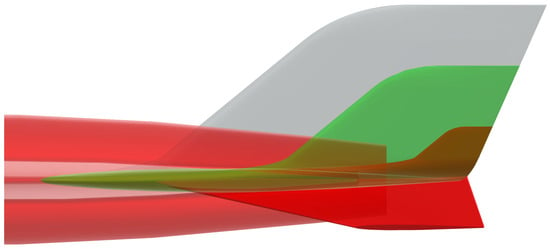
Figure 2.
Winglet scaling. Gray: scale = 1, green: scale = 0.6, red: scale = 0.2.
The trim condition is achieved by symmetric deflections of the elevons, i.e., control surfaces located at the trailing edge of the wing (see Figure 1). The center of gravity is assumed to be fixed and located in 25% MAC (mean aerodynamic chord). The moments of inertia were measured for a basic configuration (scale = 1) using a CAD model of the aircraft and were assumed to be constant between cases. The CAD model includes all structural components, skin thicknesses, and material properties. The components, such as actuators, engine, battery, etc., that is all systems necessary for flight, were taken into account in the calculations of the total moments of inertia by adding their contribution to mass distribution in a separate worksheet.
2.2. Simplified Stability Analysis
The simplified stability analysis is based on stability derivatives. For this study, they were calculated using a CFD (Computational Fluid Dynamics) software described below. The experimental verification in the literature confirms that this approach correctly identifies the tendency of how derivatives change with geometrical modifications, e.g., []. The stability derivatives describe how aerodynamic coefficients change with a given parameter, e.g., sideslip angle () or angular rates (p—roll rate, q—pitch rate, r—yaw rate). They are used for initial assessment of dynamic stability even for unconventional configurations, for example, in [,,]. However, as long as static stability is assured, the sheer value of the derivative is not the most important, but it is the relation between the derivatives that determines whether the aircraft is dynamically stable. This relation is described by the equations of motion, but solving them would be too time-consuming for optimization at the preliminary design stage, when many variations of geometry are considered. Thus, for this study, a simplified dynamic stability analysis was conducted.
2.3. MGAERO
MGAERO is a commercial software that was used for aerodynamic analysis and to compute stability derivatives. The software is based on Euler’s equations []. They model vortex and compressible flows without viscosity to compute the flow field around the aircraft. To speed up the computation, MGAERO utilizes multigrid scheme [], so that the mesh stays consistent between various geometries. Thanks to this, the error from differences in meshes is minimized, and a reliable comparison of results is possible []. This combination constitutes a reasonable balance between calculation time and accuracy, making it a mid-fidelity model. With proper preparation of a model, such an approach is sufficient to evaluate stability derivatives [].
One of the software’s functions is computation of the trim condition according to the assumed lift and pitching moment coefficients. So, results are the control surface deflection and angle of attack, which satisfy the assumed trim condition. Control surface deflection was modeled by rotation of surface’s normal. This term is a low-cost method to compute the surface control deflection without the model mesh modification. This approach is well described in the literature, e.g., [,]. The geometry of the control surfaces is shown in Figure 3.
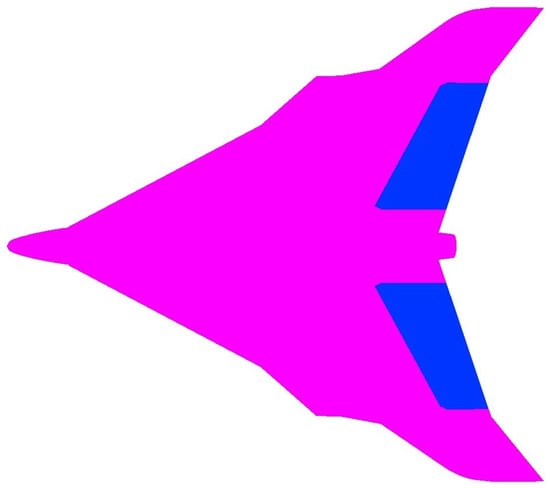
Figure 3.
Control surfaces area.
The model used for analysis consists of Multigrid blocks: seven levels and surface mesh, comprising 52,524 on-body panels and 13,146,418 off-body panels. The exemplary geometry and mesh are shown in Figure 4.

Figure 4.
Geometrical and numerical model of the aircraft. Winglets’ scale = 1.
2.4. Ansys Fluent
Ansys Fluent is an advanced commercial software for simulating fluid flow using different models, including Reynolds-Averaged Navier–Stokes (RANS) equations. This approach is applied in the presented study. It simplifies the analysis in comparison with direct solution of the Navier–Stokes equations by decomposing the turbulent fluctuations into a mean value and fluctuations from this mean value []. Steady-state calculations were carried out. A two-equation Generalized k- (GEKO) turbulence model with the Curvature Correction option was used. By changing the parameters of this model, the behavior of different turbulence models can be simulated. For this analysis, the parameters were set at values that give results similar to the SST (Shear Stress Transport) k- model [], as it gives sufficiently accurate results for low angles of attack even for vortex flow []. SST k- model uses k- approach near the walls while for the rest of the flow, a k- model is applied. This way, the advantages of both models are combined []. For the flow region near the aircraft surface, the approach that adapts wall functions was used. In general, GEKO turbulence model is y+-insensitive, but y+ values, which lie in a logarithmic region of the law of the wall, are recommended, so such values were assured.
The mesh consists of around 6 million elements for each case (Figure 5). Such a mesh count is based on the sensitivity analysis, as less dense meshes diminish accuracy, while higher mesh counts do not affect the results significantly, while the computational cost increases. The results of the sensitivity analysis are shown in Figure 6 (example case of = 6°, = 12° for scale = 1). The size of the computational domain was estimated based on typical dimensions used in the literature. It was also verified that larger domain dimensions do not affect the results. The length of the computational domain in the direction of the flow is equal to 20·MAC, the height is equal to 13·MAC, and the width is equal to 10·b (wingspan). As for the boundary conditions, the velocity inlet and pressure outlet conditions were applied at the outer surface of the computational domain. On the aircraft’s surface, a no-slip wall condition was utilized. Additionally, the changes in the angle of attack and sideslip were enforced by rotating a spherical part of the mesh with the aircraft inside, so the boundary condition of the interface was applied on the spherical surface. For each case, the minimum value of the parameter for assessing the quality of the mesh (Orthogonal Quality) was around 0.2, which corresponds to a mesh of good quality.
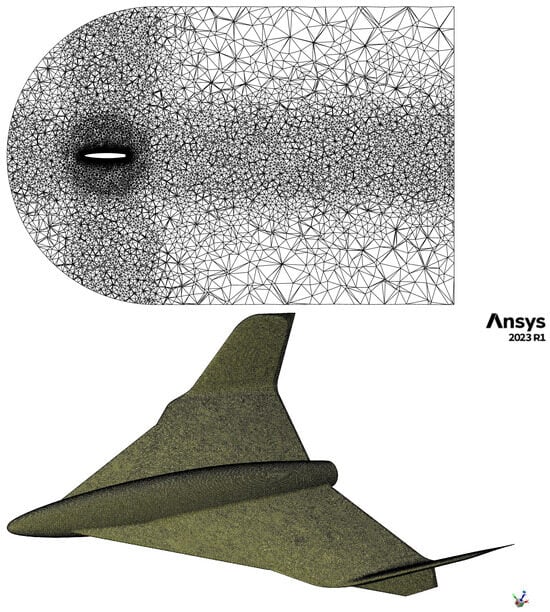
Figure 5.
Mesh cross-section for Ansys Fluent calculations (up) and axonometric view of the surface mesh (down).

Figure 6.
Mesh sensitivity analysis for Ansys Fluent.
In comparison with MGAERO, Ansys Fluent is characterized by higher accuracy, but the computational cost is also significantly higher, especially when calculating the stability derivatives with respect to angular rates. Thus, only a limited number of cases were considered for Ansys Fluent, and they serve as verification for results obtained using MGAERO. The Ansys Fluent model is based on the CAD model, but for MGAERO, the model is built in a traditional way. Moreover, MGAERO software uses only the Cartesian mesh to solve the flow around the aircraft. Because of this, the transition between the leading edge of the wing and the winglet differs between both software models, but the lack of smooth transition in the MGAERO model does not affect the results because of methods employed in flow modeling, so the comparison remains valid.
2.5. Scope of Analysis
The analysis of winglets’ impact was divided into three steps:
- The investigation of the trim condition for one assumed design lift coefficient.
- The investigation of necessary stability derivatives (due to angle of attack, sideslip, and angular rates) obtained for trim condition.
- The investigation of dynamic stability by simplified analysis.
All analyses were for a cruise airspeed of 40 m/s and flight close to the ground (air density kg/m3), so the cruising lift coefficient is equal to 0.2. The assumption of small perturbation for both sideslip angle and angular rates was introduced for simplification, as for a considered unconventional configuration the sideslip derivatives depend on the sideslip itself []. The aerodynamic coefficients were obtained from both software models for a state with and without perturbation using quasi-steady model, and the derivatives were calculated using the forward difference method. All calculations were conducted using MGAERO software, with Ansys Fluent acting only as a verification for selected cases.
3. Aerodynamic Analysis
The first results consist of pressure coefficient () distributions. Figure 7 presents the distribution for two cases: with and without winglets. Significant impact on may be observed. Additionally, in Figure 8, an exemplary distribution obtained from Ansys Fluent is shown.
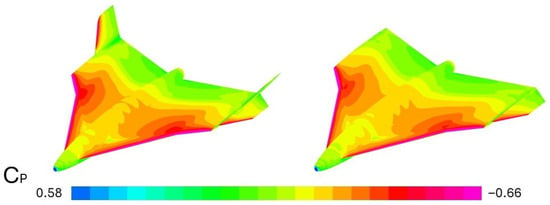
Figure 7.
distribution for scale = 0.6 (left) and scale = 0.0 (right) from MGAERO.
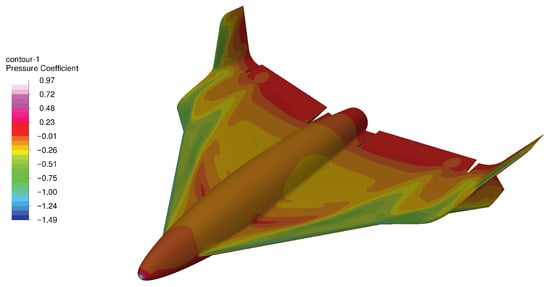
Figure 8.
distribution for scale = 0.6 from Ansys Fluent.
The relative difference between the results for both software for most derivatives does not exceed 20% (Table 1). More importantly, the tendency for derivatives to change with scale is the same for both software models, confirming the validity of the applied approach.

Table 1.
Comparison of selected derivatives between MGAERO and Ansys Fluent.
The differences in numerical results for both software models mainly come from differences in the modeling strategy and in the CFD method. First of all, in MGAERO, the numerical mesh—both on-body and off-body—is a Cartesian mesh. It is caused by using the multigrid scheme []. This method allows for creating the numerical mesh very quickly, but the model shape and configuration should not to be too complicated. Next, the vortex flow modeling made using MGAERO generates rather weak vortices. It is connected with the blunt shape of wing’s leading edge, which generates weak vortices. Moreover, the flow modeled via MGAERO excludes the viscosity effects. And finally, the aircraft model belongs to strongly aerodynamically coupled configurations.
3.1. Trim Condition
The first quantitative result was the trim condition for the design lift coefficient equal to 0.2. The trim condition consists of the angle of attack (AoA) and the deflection of control surfaces for a given value. The AoA that satisfies the trim condition is close to 6° and remains nearly identical for all considered cases. Figure 9 (left) presents the necessary control surface deflection with respect to the winglets’ scale. The reduction in the winglets’ surface caused the reduction in the necessary deflection, and this leads to an increase in the L/D ratio (Figure 9 right). The increase in L/D is nonlinear. Below scale 0.2, L/D starts to decrease.
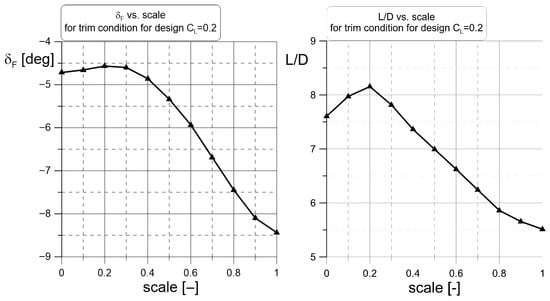
Figure 9.
Control surface deflection necessary for the trim condition for design lift coefficient (left) and lift-to-drag ratio (L/D) for trim condition (right).
3.2. Stability Derivatives
Next, the change in basic stability derivatives was researched. Mainly, the derivatives connected with sideslip and angular rates were investigated. Figure 10 presents the change in stability derivatives due to sideslip angle— and —with respect to the winglets’ scale. A significant nonlinear reduction and fast change may be observed. The impact is connected with the change in the surface and the change in the point of application of the resultant force. Moreover, the modification in the geometry and position of the winglets changes the impact of the vortex shed from the LEX.
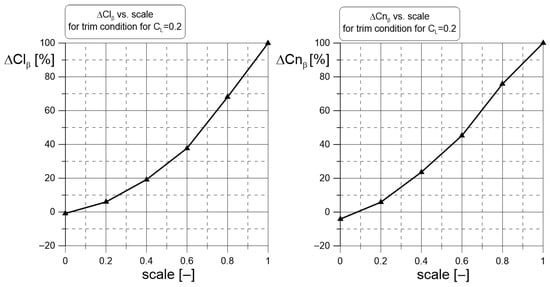
Figure 10.
The change of derivatives with respect to sideslip— and vs. winglets’ scale.
The next step of the analysis consists of the computation of angular rate derivatives. All directions of rotation were considered. Firstly, the roll rate (Figure 11) presents a maximum reduction in equal to 60%. As for , the change in sign for the low scales is observed. For both cases, the rapid decrease of derivatives with respect to the basic configuration (scale = 1) may be observed.
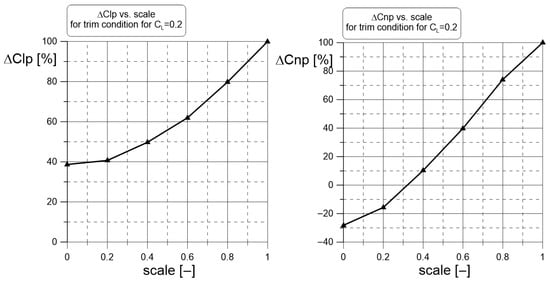
Figure 11.
The change in derivatives with respect to roll rate— and vs. winglets’ scale.
The next case consists of the analysis of stability derivatives in the longitudinal channel. Figure 12 presents the change in the lift and pitching-moment derivatives with respect to the pitch rate versus winglets’ scale. For scales from 0.4 to 1.0, the change is low. But for lower scales, the change in the pitching moment is rapid and almost linear—up to a 60% reduction for a scale = 0 (aircraft without winglets).
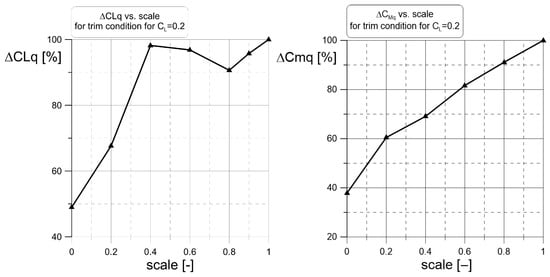
Figure 12.
The change in derivatives with respect to pitch rate— and vs. winglets’ scale.
The last step of the aerodynamic analysis was devoted to the analysis of the change in the roll and yaw moment due to the yaw rate, and , respectively (Figure 13). The same as for the case of , the change in these derivatives is nonlinear and rapid. Moreover, for , the sign change is observed.
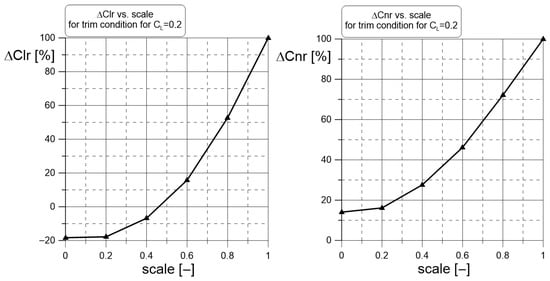
Figure 13.
The change in derivatives with respect to yaw rate— and vs. winglets’ scale.
4. Dynamics Stability
4.1. Theory
The following modes of motion were considered: spiral, roll, Dutch roll, and short-period oscillations []. The phugoid was not considered, as it mostly concerns aircraft with high lift-to-drag (L/D) ratios, which is not the studied case. The evaluated quantities were as follows: time to half-damping (spiral mode), time constant (roll mode), and damping ratio (Dutch roll and short-period modes). The simplified expressions for those parameters, dependent on dimensional derivatives (derived from dimensionless derivatives as in ref. []), are present in the literature, e.g., [,]. In ref. [], the above-described simplified analysis was conducted, and the results were compared with experimental measurements. One of the main conclusions was that the computations for lateral motions are more accurate than for longitudinal motions. The largest error was for short-period oscillations, but at the same time, the computations were more pessimistic than flight tests results.
4.2. Results
As was mentioned, the four modes were considered. The simplified model was used to assess the impact of winglets’ size on dynamics. The first analyzed mode is a spiral mode. Figure 14 presents the time to half-damping for spiral mode. The time is reduced by about 24% for winglets’ scale from 0.3 up to 0.8. Results for scale 0 (without winglets) are not present in Figure 14 because the spiral mode is divergent (time to half-damping changes into time to double amplitude).
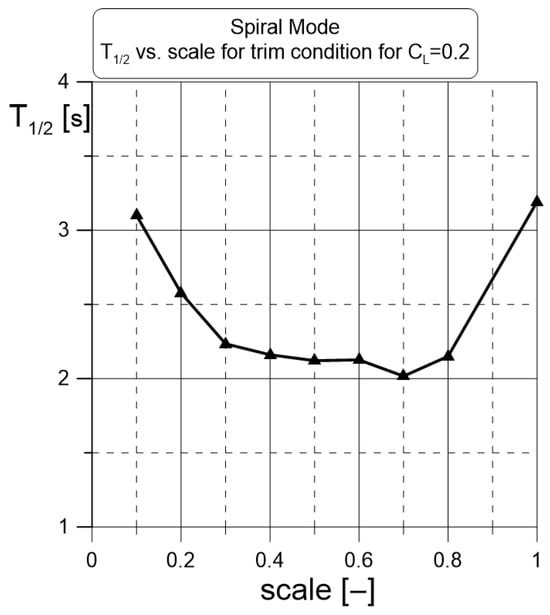
Figure 14.
Time to half-damping for spiral mode vs. winglets’ scale.
The next analyzed mode is the Dutch roll. In this mode, the damping ratio and ratio were analyzed. Figure 15 presents the damping ratio for this mode. A highly nonlinear curve was obtained. The minimum value of the damping ratio was obtained for a scale equal to 0.3. At first, a decrease in the scale decreases the damping, but below scale 0.3, it increases again.
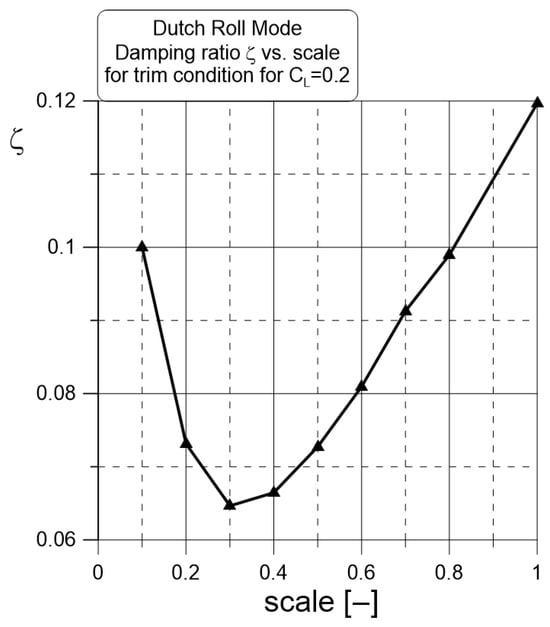
Figure 15.
Dutch roll mode damping ratio vs. winglets’ scale.
Figure 16 presents the ratio of lateral derivatives . First of all, the ratio for the case without winglets is unacceptable (change in the sign and the value), as it makes the configuration unstable. For non-zero scales, the character of the curve is the same as for the Dutch roll damping ratio (Figure 15).
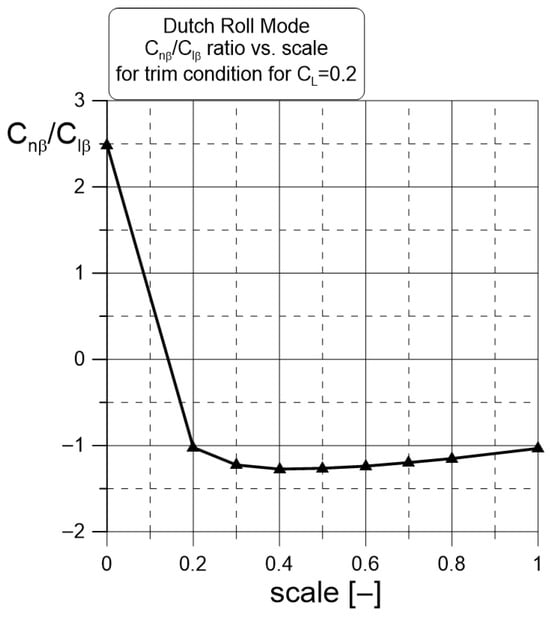
Figure 16.
ratio vs. winglets’ scale.
The next analyzed mode is an aperiodic roll mode. Figure 17 presents the time constant with respect to the winglets’ scale. The time constant increases when the winglets’ area decreases, leading to lower stability of this mode.
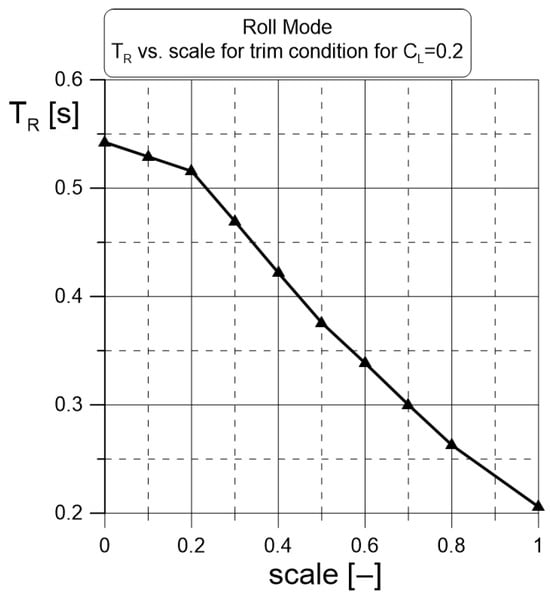
Figure 17.
Roll mode time constant vs. winglets’ scale.
The last analyzed mode is the short period, which is the only longitudinal mode used for the analysis (Figure 18). It was considered because of the identification of the significant impact of the winglets on the longitudinal characteristics. The analysis reveals that the damping ratio increases rapidly up to the half of the range and then decreases, but only marginally.
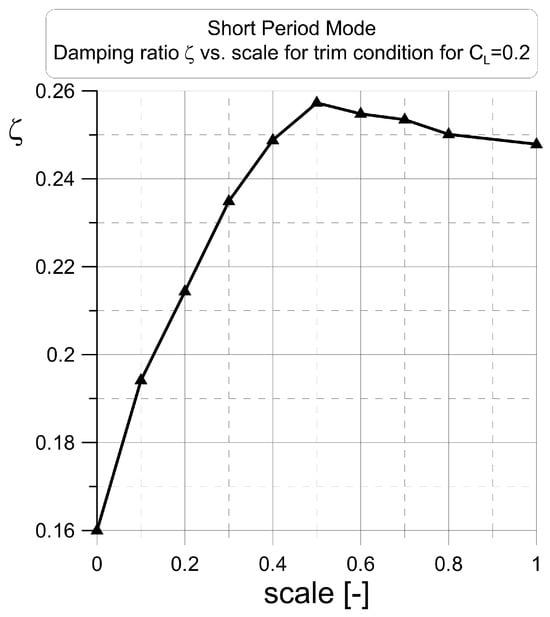
Figure 18.
Short-period damping ratio vs. winglets’ scale.
The lateral and directional characteristics of the aircraft are mostly affected by the force generated by the winglets. When some kind of asymmetry occurs (e.g., due to sideslip), the vortices begin to affect both of the upper winglets differently. On one side of the aircraft, the vortices move closer to the winglet, strengthening their impact. On the other side, the vortices move away, and their impact weakens (Figure 19). When the winglets are scaled, the asymmetry itself is weaker because the surface affected by the vortices is smaller. This impairs the dampening, so derivatives connected to side characteristics are generally lower for smaller upper winglets.
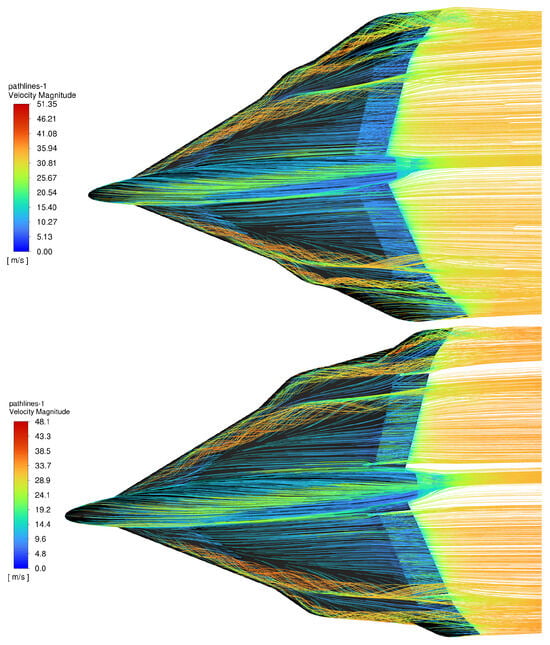
Figure 19.
The pathlines for = 6° and = 5° for scale = 1 (up) and scale = 0.5 (down).
Apart from changing the surface of the winglets, scaling them also leads to exposing a bigger part of the main wing. Because of the swept leading edge, the main wing generates the vortices similarly as the LEX. When more of the main wing is exposed due to the backing out of the winglet, those vortices develop differently (Figure 19). This phenomenon affects the characteristics in all channels (longitudinal, lateral and directional). This is a possible cause behind the nonlinear change in derivatives with winglets’ scale, but to fully understand this subject, an in-depth analysis would be needed, and it is not considered in this paper.
5. Summary and Conclusions
This work was completely devoted to investigating the impact of the winglets’ geometry on the aerodynamic and dynamic features of the aircraft in a tailless configuration. The research reveals that the impact is significant both in the longitudinal and lateral directions. This change is caused by a change in the winglets’ area, the position of resultant force, and the necessary trim condition.
The presented dynamic stability results were obtained using a simplified method. Nevertheless, they allow for assessing the potential impact of geometrical modifications on the stability and control of the aircraft. The knowledge of these relationships may allow us to choose proper parameters for the winglets. The results from this paper, especially the conclusions presented below, can be used as guidelines by designers to assess what changes they should apply to winglets for a tailless aircraft to achieve static and dynamic stability. Depending on where the problem lies, e.g., whether short period or Dutch roll are unstable, they can adopt the appropriate correction in the winglets’ size.
Most of the stability derivatives shown in Section 3 change nonlinearly with winglets’ scale. The same is true for the quantities presented in Section 4, which describe the dynamic stability of the aircraft. Because of this nonlinearity, it is hard to determine which winglets’ scale is the most optimal, as the answer to this question strongly depends on the criterion. Based on the results, it can be concluded that decreasing the scale has the following effects:
- It decreases the control surface deflection necessary for trim for a given ;
- It increases the lift-to-drag-ratio (down to the scale of 0.2);
- It decreases all considered stability derivatives (apart from , the change of which is strongly irregular);
- It first decreases (down to scale of 0.7), and then increases the time to half-damping for spiral mode;
- It first decreases (down to scale of 0.3), and then increases the Dutch roll damping ratio;
- It decreases the ratio of to , up to the point when configuration becomes unstable (no winglets);
- It increases the roll mode time constant;
- It first increases (down to scale of 0.5) and then decreases the short-period damping ratio, with the lowest value reached for no winglets.
The presented research focused only on one flight condition, defined by one trim condition for low lift coefficient. The analysis does not include higher angles of attack and the impact of a vortex shed from the LEX. This analysis should be supported by wind tunnel tests, because numerical software struggle with accurate modeling of vortex flow []. Wind tunnel tests are planned by the Authors as further work.
Author Contributions
Conceptualization, K.K. and M.F.; Methodology, K.K.; Validation, M.F. and T.G.-G.; Writing—original draft, K.K. and M.F.; Writing—review and editing, T.G.-G. and K.K.; Supervision, T.G.-G. All authors have read and agreed to the published version of the manuscript.
Funding
This research received no external funding.
Data Availability Statement
The original contributions presented in this study are included in the article. Further inquiries can be directed to the corresponding author.
Conflicts of Interest
The authors declare no conflicts of interest.
Abbreviations
The following abbreviations are used in this manuscript:
| AoA | angle of attack |
| CFD | Computational Fluid Dynamics |
| GEKO | Generalized k-omega |
| LEX | leading-edge extension |
| L/D | lift-to-drag ratio |
| MAC | mean aerodynamic chord |
| RANS | Reynolds-Averaged Navier-Stokes |
| SST | Shear Stress Transport |
| sideslip angle | |
| p | roll rate |
| q | pitch rate |
| r | yaw rate |
| control surface deflection [deg] | |
| lift coefficient | |
| the change of stability derivative—the rolling moment coefficient | |
| with respect to the sideslip angle | |
| the change of stability derivative—the yawing moment coefficient | |
| with respect to the sideslip angle | |
| the change of stability derivative—the rolling moment coefficient | |
| with respect to the roll rate | |
| the change of stability derivative—the yawing moment coefficient | |
| with respect to the roll rate | |
| the change of stability derivative—the lift coefficient | |
| with respect to the pitch rate | |
| the change of stability derivative—the pitching moment coefficient | |
| with respect to the pitch rate | |
| the change of stability derivative—the rolling moment coefficient | |
| with respect to the yaw rate | |
| the change of stability derivative—the yawing moment coefficient | |
| with respect to the yaw rate | |
| time to half-damping | |
| damping ratio | |
| time constant |
References
- Olson, E.; Selberg, B. Experimental determination of improved aerodynamic characteristics utilizing biplane wing configurations. J. Aircr. 1976, 13, 256–261. [Google Scholar] [CrossRef]
- Nickel, K.; Wohlfahrt, M. Tailless Aircraft in Theory and Practice; AIAA Education Series; American Institute of Aeronautics and Astronautics: Reston, VA, USA, 1994. [Google Scholar]
- Minardo, A. The Tandem Wing: Theory, Experiments, and Practical Realisations. Master’s Thesis, Politecnico di Milano, Milano, Italy, 2014. [Google Scholar]
- Galiński, C.; Stalewski, W.; Lis, M.; Hajduk, J. Overview of the inverted joined wing scaled demonstrator programme. In Proceedings of the 30th Congress of the International Council of the Aeronautical Sciences, Daejeon, Republic of Korea, 25–30 September 2016. [Google Scholar]
- Ghasemzadeh, A.; Banazadeh, A. Comprehensive Review of Design and Performance Metrics in Three-Surface Aircraft. J. Aircr. 2025, 62, 731–747. [Google Scholar] [CrossRef]
- Hao, C.; Wang, H. Prediction of Lift Coefficient for Tandem Wing Configuration or Multiple-Lifting-Surface System Using Prandtl’s Lifting-Line Theory. Int. J. Aerosp. Eng. 2018, 2018, 1–15. [Google Scholar] [CrossRef]
- Jones, R.; Cleaver, D.; Gursul, I. Aerodynamics of Biplane and Tandem Wings at Low Reynolds Numbers. Exp. Fluids 2015, 56, 124. [Google Scholar] [CrossRef]
- Figat, M.; Kwiek, A. Analysis of longitudinal dynamic stability of tandem wing aircraft. Aircr. Eng. Aerosp. Technol. 2023, 95, 1411–1422. [Google Scholar] [CrossRef]
- Lai, W. The working principles of canard wings and its aerodynamic advantages and effects on aircraft. Appl. Comput. Eng. 2024, 91, 83–88. [Google Scholar] [CrossRef]
- Goetzendorf-Grabowski, T. Flight dynamics of unconventional configurations. Prog. Aerosp. Sci. 2023, 137, 100885. [Google Scholar] [CrossRef]
- Goraj, Z.; Kulicki, P.; Lasek, M. Aircraft Stability Analysis for Strongly Coupled Aerodynamic Configuration. J. Theor. Appl. Mech. 1997, 35, 137–158. [Google Scholar]
- Goetzendorf-Grabowski, T.; Kwiek, A. Study of the Impact of Aerodynamic Model Fidelity on the Flight Characteristics of Unconventional Aircraft. Appl. Sci. 2023, 13, 12522. [Google Scholar] [CrossRef]
- Kwiek, A. A numerical study into the longitudinal dynamic stability of the tailless aircraft. Aircr. Eng. Aerosp. Technol. 2019, 91, 428–436. [Google Scholar] [CrossRef]
- Kwiek, A. Conceptual design of an aircraft for Mars mission. Aircr. Eng. Aerosp. Technol. 2019, 91, 886–892. [Google Scholar] [CrossRef]
- Stenfelt, G.; Ringertz, U. Yaw Control of a Tailless Aircraft Configuration. J. Aircr. 2010, 47, 1807–1810. [Google Scholar] [CrossRef]
- Kwiek, A. Study on Control and Stability of the Rocket Plane to Space Tourism. In Proceedings of the 29th Congress of the International Council of the Aeronautical Sciences (ICAS 2014), St. Petersburg, Russia, 7–12 September 2014. [Google Scholar]
- Welstead, J.; Crouse, G.L. Conceptual Design Optimization of an Augmented Stability Aircraft Incorporating Dynamic Response and Actuator Constraints. In Proceedings of the 52nd Aerospace Sciences Meeting, National Harbor, MD, USA, 13–17 January 2014; American Institute of Aeronautics and Astronautics: Reston, VA, USA, 2014. [Google Scholar] [CrossRef]
- Kwiek, A. Study on the Static and Dynamic Stability of a Modular Airplane System. Aviation 2016, 20, 160–167. [Google Scholar] [CrossRef]
- Charruaz, G.; Borgia, A.; Braghin, A.; Bussi, T.; Esposito, A.; Pescosolido, A. Flight Performance And Dynamics of an Unconventional Solar Powered UAS. In Proceedings of the 34th Congress of the International Council of the Aeronautical Sciences (ICAS), Florence, Italy, 9–13 September 2024. [Google Scholar]
- Raza, H.; Maqsood, A.; Masud, J. Altering flight stability characteristics of a high-performance aircraft through wing strake modification. Aeronaut. J. 2024, 128, 2105–2125. [Google Scholar] [CrossRef]
- Figat, M.; Kwiek, A. Aerodynamic and static stability investigation into aircraft coupled system to suborbital space flights. Aircr. Eng. Aerosp. Technol. 2021, 93, 275–283. [Google Scholar] [CrossRef]
- Esteban, S. Static and dynamic analysis of an unconventional plane—Flying wing. In Proceedings of the AIAA Atmospheric Flight Mechanics Conference and Exhibit, Montreal, Canada, 6–9 August 2001; American Institute of Aeronautics and Astronautics: Reston, VA, USA, 2001. [Google Scholar] [CrossRef]
- Mulh, J.C. Low-Speed Aerodynamic Characteristics of a Delta Wing withArticulated Wingtips, Elevons, and Leading-Edge Vortex Flaps. Bachelor’s Thesis, The Ohio State University, Columbus, OH, USA, 2022. [Google Scholar]
- Verhaagen, N.; Jobe, C. Effects of Sideslip on the Characteristics of a 65-deg Delta Wing. In Proceedings of the 41st Aerospace Sciences Meeting and Exhibit, Reno, Nevada, 6–9 January 2003; American Institute of Aeronautics and Astronautics: Reston, VA, USA, 2003. [Google Scholar] [CrossRef]
- Luckring, J. Reynolds numer, compressibility and leading-edge bluntness effects on delta-wing aerodynamics. In Proceedings of the 24th Congress of the International Council of the Aeronautical Sciences (ICAS), Yokohama, Japan, 29 August–3 September 2024. [Google Scholar]
- Goertz, S. Realistic Simulations of Delta Wing Aerodynamics Using Novel CFD Methods. Ph.D. Thesis, Royal Institute of Technology (KTH), Stockholm, Sweden, 2005. [Google Scholar]
- Gursul, I.; Gordnier, R.; Visbal, M. Unsteady aerodynamics of nonslender delta wings. Prog. Aerosp. Sci. 2005, 41, 515–557. [Google Scholar] [CrossRef]
- Figat, M.; Kwiek, A. Aerodynamic optimisation of the rocket plane in subsonic and supersonic flight conditions. Proc. Inst. Mech. Eng. Part G J. Aerosp. Eng. 2017, 231, 2266–2281. [Google Scholar] [CrossRef]
- Granata, D.; Savino, A.; Zanotti, A. Numerical Evaluation of Aircraft Aerodynamic Static and Dynamic Stability Derivatives by a Mid-Fidelity Approach. Aerospace 2024, 11, 213. [Google Scholar] [CrossRef]
- Goetzendorf-Grabowski, T.; Marcinkiewicz, E.; Galiński, C. Comparison of traditionally calculated stabilitycharacteristics with flight test data of PW-6U sailplane. In Proceedings of the 4th CEAS Air & Space Conference, Linköping, Sweden, 16–19 September 2013; pp. 536–543. [Google Scholar]
- Kwiek, A.; Figat, M. An investigation into directional characteristics of the rocket plane in a tailless configuration. CEAS Space J. 2022, 15, 627–640. [Google Scholar] [CrossRef]
- Kwiek, A.; Figat, M. LEX and wing tip plates’ interaction on the Rocket Plane in tailless configuration. Aeronaut. J. 2016, 120, 255–270. [Google Scholar] [CrossRef]
- MGAERO. A Cartesian Multigrid Euler Code for Flow Around Arbitrary Configurations—User’s Manual Version 3.1.4; Analytical Methods, Inc. (AMI): Renton, WA, USA, 2001. [Google Scholar]
- Ansys Fluent Fluid, Simulation Software. 2025. Available online: www.ansys.com/products/fluids/ansys-fluent (accessed on 2 October 2025).
- Panagiotou, P.; Antoniou, S.; Yakinthos, K. Cant angle morphing winglets investigation for the enhancement of the aerodynamic, stability and performance characteristics of a tactical Blended-Wing-Body UAV. Aerosp. Sci. Technol. 2022, 123, 107467. [Google Scholar] [CrossRef]
- Ruffels, W.R.; Dakka, S. Aerodynamic flow characteristics of utilizing delta wing configurations in supersonic and subsonic flight regimes. J. Commun. Comput. 2016, 13, 299–318. [Google Scholar] [CrossRef]
- Al-Garni, A.Z.; Saeed, F.; Al-Garni, A.M. Experimental and Numerical Investigation of 65 Degree Delta and 65/40 Degree Double-Delta Wings. J. Aircr. 2008, 45, 71–76. [Google Scholar] [CrossRef]
- Frink, N.T.; Lamar, J.E. Analysis of Strake Vortex Breakdown Characteristics in Relation to Design Features. J. Aircr. 1981, 18, 252–258. [Google Scholar] [CrossRef]
- Lamar, J.E.; Frink, N.T. Aerodynamic Features of Designed Strake-Wing Configurations. J. Aircr. 1982, 19, 639–646. [Google Scholar] [CrossRef]
- Mitchell, A.M.; Délery, J. Research into vortex breakdown control. Prog. Aerosp. Sci. 2001, 37, 385–418. [Google Scholar] [CrossRef]
- Rao, D.M.; Campbell, J.F. Vortical flow management techniques. Prog. Aerosp. Sci. 1987, 24, 173–224. [Google Scholar] [CrossRef]
- Luckring, J.M. Aerodynamics of Strake-Wing Interactions. J. Aircr. 1979, 16, 756–762. [Google Scholar] [CrossRef]
- Kaptsov, O.V. Solutions of the Euler equations and stationary structures in an inviscid fluid. arXiv 2022, arXiv:2202.06294. [Google Scholar] [CrossRef]
- Mavriplis, D.J. Three-dimensional unstructured multigrid for the Euler equations. AIAA J. 1992, 30, 1753–1761. [Google Scholar] [CrossRef]
- Katz, J.; Plotkin, A. Low-Speed Aerodynamics: From Wing Theory to Panel Methods, 1st ed.; McGraw-Hill: New York, NY, USA, 1991. [Google Scholar]
- Menter, F.R.; Matyushenko, A. Generalized k-ω (GEKO) Two-Equation Turbulence Model. AIAA J. 2025, 1–17. [Google Scholar] [CrossRef]
- Wibowo, S.; Sutrisno; Rohmat, T.A. An evaluation of turbulence model for vortex breakdown detection over delta wing. Arch. Mech. Eng. 2018, 65, 399–415. [Google Scholar] [CrossRef]
- Menter, F.; Kuntz, M.; Langtry, R. Ten years of industrial experience with the SST turbulence model. Heat Mass Transf. 2003, 4, 625–632. [Google Scholar]
- Corsiglia, V.R.; Koenig, D.G.; Morelli, J.P. Large-Scale Tests of an Airplane Model with a Double-Delta Wing, Including Longitudinal and Lateral Characteristics and Ground Effects; NASA Technical Note NASA-TN-D-5102; NASA: Washington, DC, USA, 1969. [Google Scholar]
- Nelson, R. Flight Stability and Automatic Control, 2nd ed.; McGraw-Hill: New York, NY, USA, 1998. [Google Scholar]
- Nondimensional Equations of Motion. Available online: https://aircraftflightmechanics.com/Linearisation/Nondimensional.html (accessed on 17 September 2025).
- Rizzi, A.; Luckring, J. Historical development and use of CFD for separated flow simulations relevant to military aircraft. Aerosp. Sci. Technol. 2021, 117, 106940. [Google Scholar] [CrossRef]
Disclaimer/Publisher’s Note: The statements, opinions and data contained in all publications are solely those of the individual author(s) and contributor(s) and not of MDPI and/or the editor(s). MDPI and/or the editor(s) disclaim responsibility for any injury to people or property resulting from any ideas, methods, instructions or products referred to in the content. |
© 2025 by the authors. Licensee MDPI, Basel, Switzerland. This article is an open access article distributed under the terms and conditions of the Creative Commons Attribution (CC BY) license (https://creativecommons.org/licenses/by/4.0/).